Spring - MVC Framework Tutorial
Introduction to Spring MVC Framework
Spring MVC is used to develop the web applications that uses MVC design pattern. By using Spring MVC we can build flexible and loosely coupled web applications.The MVC design pattern helps in seperating the business logic, presentation logic and controller logic. Models are responsible for encapsulating the application data. The Views render response to the user with the help of the model object . Controllers are responsible for receiving the request from the user and calling the back-end services.
Spring MVC will make application development faster, cost effective and flexible.
Advantage of Spring MVC Framework
- Clear separation of responsibilities because it implements MVC design pattern.
- Loose coupling among Model, View and Controller.
- Inbuilt front controller.
- Simplified Validation implementation.
- Simplified Exception Handling.
- Tiles Support.
- Internationalization logic is simplified compared to other frameworks.
- Spring MVC provides a set of custom tags which are useful to implement presentation logic easily.
Introduction to Spring MVC Framework
Spring MVC is used to develop the web applications that uses MVC design pattern. By using Spring MVC we can build flexible and loosely coupled web applications.The MVC design pattern helps in separating the business logic, presentation logic and controller logic. Models are responsible for encapsulating the application data. The Views render response to the user with the help of the model object . Controllers are responsible for receiving the request from the user and calling the back-end services.
Spring MVC will make application development faster, cost effective and flexible.
Advantage of Spring MVC Framework
- Clear separation of responsibilities because it implements MVC design pattern.
- Loose coupling among Model, View and Controller.
- Inbuilt front controller.
- Simplified Validation implementation.
- Simplified Exception Handling.
- Tiles Support.
- Internationalization logic is simplified compared to other frameworks.
- Spring MVC provides a set of custom tags which are useful to implement presentation logic easily.
Spring MVC Flow

- Client(Browser) requests for a Resource in the web Application.
- The Spring front controller i.e, DispatcherServlet first receives the request.
- DispatcherServlet consults the HandlerMapping to identify the particular controller for the given URL.
- HandlerMapping identifies the controller for the given request and sends to the DispatcherServlet.
- DispatcherServlet will call the handleRequest(request,response) method on Controller. A Controller is developed by writing a simple java class which implements Controller interface or extends its adapter class.
- Controller will call the business method according to business requirement.
- Service class will call the DAO class method for business data.
- DAO interacts with DB to get data.
- DAO returns same data to service.
- Fetched data will be processed according to business requirement and return results to Controller.
- The Controller returns the Model and View in the form of Object back to the Controller i.e, DispatcherServlet.
- The front controller i.e, DispatcherServlet then tries to resolve the actual View which may be JSP,velocity or Free Marker by consulting the View Resolver Object.
- ViewResolver selected view is rendred back to the DispatcherServlet.
- DispatcherServletconsult the particular view with the model.
- View executes and returns HTML output to the DispatcherServlet.
- DispatcherServlet will sends the output to the Browser.
Spring MVC Example:
The following example show how to write a simple web based Hello World application using Spring MVC framework.
Tools Used:
- JDK 1.5 or above
- Eclipse Juno
- Tomcat 6.x above
- Spring 4.X JAR files
Directory Structure
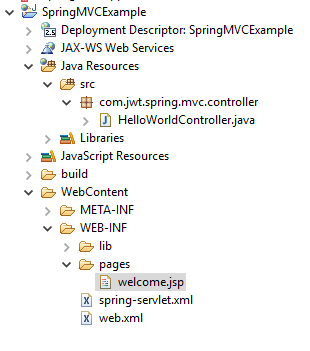
Follow the below steps to create a simple Spring MVC example.
Step 1 : Create Dynamic Web Project
Open Eclipse and navigate to File -> New and select Dynamic Web Project as shown below.
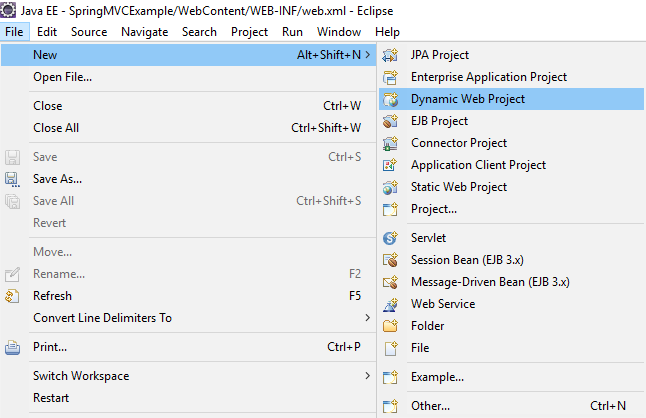
After selecting Dynamic Web Project, press Next and provide name of the project as SpringMVCExample and click on Finish.
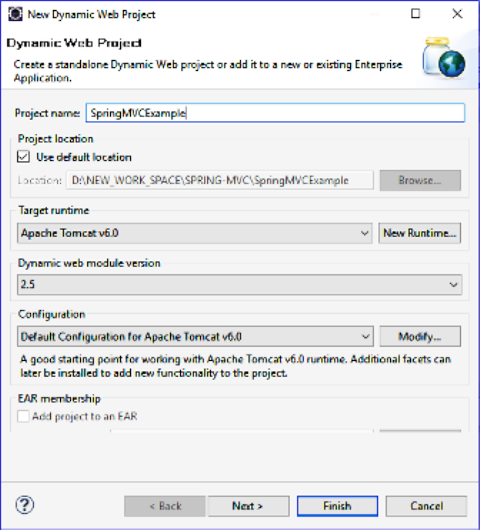
Step 2 : Add Jar files to the project
Now copy all the required JAR files in WebContent -> WEB-INF -> lib folder.The following jar files should be added to the build path of the project for successful deployment of Spring MVC project :
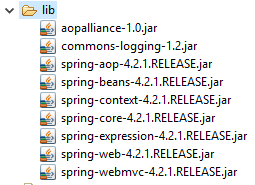
Step 3 : Provide the entry of controller in the web.xml file
Following is the content of Spring Web configuration file web.xml.The web.xml file will be kept WebContent/WEB-INF directory of your web application.
web.xml
<web-app id="WebApp_ID" version="2.4" xmlns="http://java.sun.com/xml/ns/j2ee" xmlns:xsi="http://www.w3.org/2001/XMLSchema-instance" xsi:schemaLocation="http://java.sun.com/xml/ns/j2ee http://java.sun.com/xml/ns/j2ee/web-app_2_4.xsd"> <display-name>Spring4MVCHelloWorldDemo Web Application</display-name> <servlet> <servlet-name>dispatcher</servlet-name> <servlet-class> org.springframework.web.servlet.DispatcherServlet </servlet-class> <init-param> <param-name>contextConfigLocation</param-name> <param-value>/WEB-INF/spring-servlet.xml</param-value> </init-param> <load-on-startup>1</load-on-startup> </servlet> <servlet-mapping> <servlet-name>dispatcher</servlet-name> <url-pattern>*.jsp</url-pattern> </servlet-mapping> </web-app>
The org.springframework.web.servlet.DispatcherServlet acts as the front controller for the application.This means DispatcherServlet receives each request and direct the request to appropriate controller.It is also responsible for directing the response from controller to appropriate views.The web.xml should be given in such a way that DispatcherServlet should be invoked for client requests.
After initialization of spring-mvc DispatcherServlet, the framework will try to load the application context from a file named [servlet-name]-servlet.xml located in the application's WebContent/WEB-INF directory.Name of the file is not fixed and it depend on the value of <servlet-name> element in web.xml. Whatever servlet-name is defined in web.xml you need to add "-servlet" in it and corresponding .xml will needs to be created in given location(WebContent>>WEB-INF).In this case our file name should be dispatcher-servlet.xml.
If you do not want to go with default file name as [servlet-name]-servlet.xml and default location as WebContent/WEB-INF, you can customize this file name and location by adding the Servlet listener ContextLoaderListener in your web.xml file as follows:
<context-param> <param-name>contextConfigLocation</param-name> <param-value>/WEB-INF/spring-servlet.xml</param-value> </context-param> <listener> <listener-class> org.springframework.web.context.ContextLoaderListener </listener-class> </listener>
Here we given spring configuration file name as spring-servlet.xml in our web.xml file.
Next, <servlet-mapping> tag indicates which URLs will be handled by the which DispatcherServlet. In our web.xml all HTTP requests ending with .jsp will be handled by the dispatcher DispatcherServlet.
Step 4 : Create the Controller Class
To create the controller class, we are using two annotations @Controller and @RequestMapping.The @Controller annotation marks this class as Controller.The @RequestMapping annotation is used to map the class with the specified name.
Create a java class HelloWorldController inside com.jwt.spring.mvc.controller package which simply adds a string into model which will be accessible to the view for our example.
package com.jwt.spring.mvc.controller;
import org.springframework.stereotype.Controller;
import org.springframework.ui.ModelMap;
import org.springframework.web.bind.annotation.RequestMapping;
import org.springframework.web.bind.annotation.RequestMethod;
@Controller
@RequestMapping("/")
public class HelloWorldController {
@RequestMapping(method = RequestMethod.GET)
public String sayHello(ModelMap model) {
model.addAttribute("msg","Welcome to javawebtutor Spring 4 MVC Tutorial");
return "welcome";
}
@RequestMapping(value="/greeting", method = RequestMethod.GET)
public String greeting(ModelMap model) {
model.addAttribute("msg", "Greetings from javawebtutor.com");
return "welcome";
}
}
In the above Controller class.
@Controller annotation marks this class as spring bean which may handle different HTTP requests based on mapping specified on class or individual controller methods.
@RequestMapping is one of the most widely used Spring MVC annotation. This annotation is used to map web requests onto specific handler classes and/or handler methods.@RequestMapping can be applied to the controller class as well as methods.
In our case, we have applied it on class level too, which says that this class is default handler for all HTTP requests of type ‘/’.@RequestMapping have several attributes [value,method,params,..] which can be used to narrow down your mapping to more specific selection.
In our controller class first method does not have any URL mapping declared, so it will inherit the mapping from mapping declared on class level, acting as default handler for GET requests. Second method (due to additional mapping declaration with value attribute) will serve the request of form /greeting. Attribute method is used to specify type of HTTP request this method can serve. If a mapping does not include "method" attribute, then that mapped controller method will server all types of request on that mapped URL.
ModelMap is a Map implementation, which provides a way to set/get attributes from/to request or session like request.getAttribute/ request.setAttribute of HttpServlet.
Step 5 : Define the Beans in Spring XML Configuration file
Create an XML file and name it dispatcher-servlet.xml. This configuration file can be given any name. We are using the name spring-servlet.xml for this project. Place this file inside the WEB-INF folder. This is the important configuration file where we need to specify the ViewResolver and View components.
<beans xmlns="http://www.springframework.org/schema/beans" xmlns:context="http://www.springframework.org/schema/context" xmlns:mvc="http://www.springframework.org/schema/mvc" xmlns:xsi="http://www.w3.org/2001/XMLSchema-instance" xsi:schemaLocation="http://www.springframework.org/schema/beans http://www.springframework.org/schema/beans/spring-beans-4.0.xsd http://www.springframework.org/schema/mvc http://www.springframework.org/schema/mvc/spring-mvc-4.0.xsd http://www.springframework.org/schema/context http://www.springframework.org/schema/context/spring-context-4.0.xsd"> <context:component-scan base-package="com.jwt.spring.mvc.controller" /> <mvc:annotation-driven /> <bean class="org.springframework.web.servlet.view.InternalResourceViewResolver"> <property name="prefix"> <value>/WEB-INF/pages/</value> </property> <property name="suffix"> <value>.jsp</value> </property> </bean> </beans>
In the above xml file <context:component-scan base-package="com.jwt.spring.mvc.controller" /> instructs spring container to scan the package (com.jwt.spring.mvc.controller) and its children to detect and auto configure components. For instance, we can annotate a class with @Controller annotation and spring will automatically configure it as a controller class. Due to this auto scanning feature, there is no need to configure controller classes in xml files.
InternalResourceViewResolver class is used for the ViewResolver.The prefix+string returned by controller+suffix page will be invoked for the view component.As our controller is returning welcome (return "welcome";) so the view will be /WEB-INF/pages/welcome.jsp.
Step 6 : Create the View
Spring MVC supports many types of views for different presentation technologies, such as JSPs, HTML, PDF, Excel worksheets, XML etc. The view part of this MVC example is a simple jsp page, that shows the value of the attribute that was set to the Controller.Create a new folder named pages under WEB-INF and create a Simple JSP page welcome.jsp inside this ( WEB-INF/pages/welcome.jsp). This jsp page will simply access the model value sent from controller.
<%@ page language="java" contentType="text/html; charset=ISO-8859-1"
pageEncoding="ISO-8859-1"%>
<!DOCTYPE html PUBLIC "-//W3C//DTD HTML 4.01 Transitional//EN" "http://www.w3.org/TR/html4/loose.dtd">
<html>
<head>
<meta http-equiv="Content-Type" content="text/html; charset=ISO-8859-1">
<title>HelloWorld page</title>
</head>
<body>
<h2>Hello : ${msg}</h2>
</body>
</html>
Output:

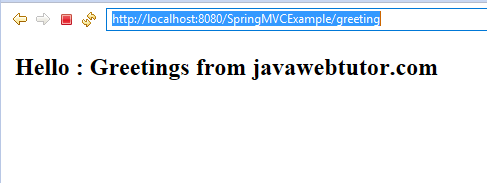
Download this example(src+lib) developed in eclipse
References:- Spring MVC Documentation
Related Articles

